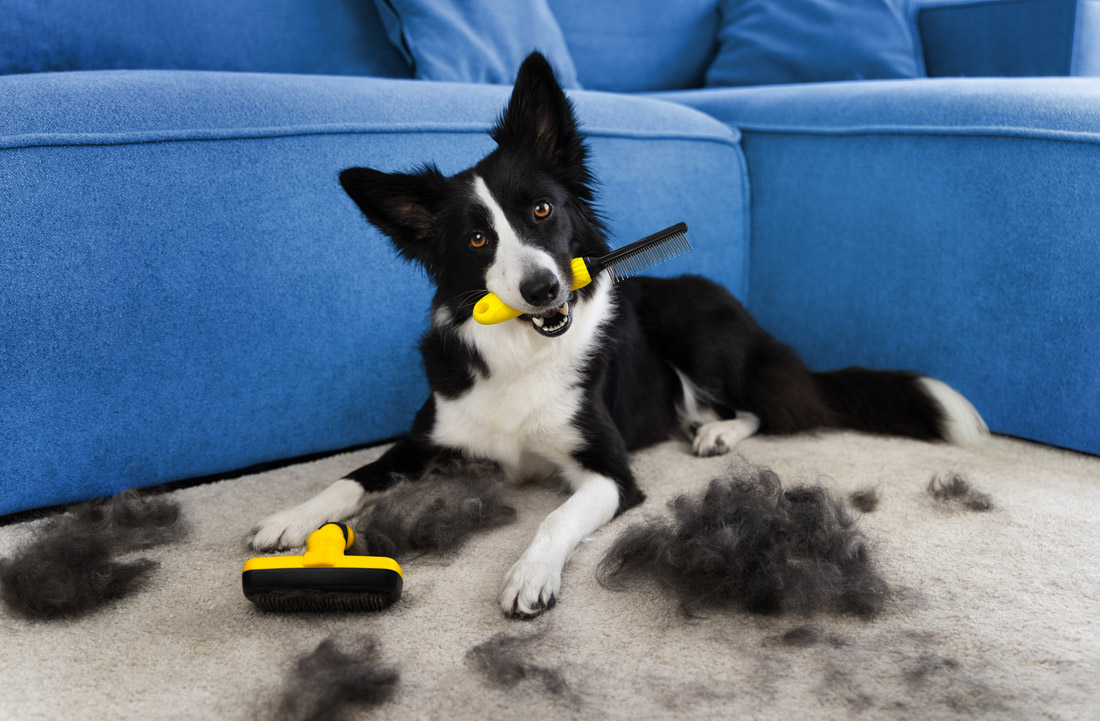Fed up with Fido’s fur? The pros can help!


It’s not just you. Your pet’s shedding is a challenge to keeping a clean home. But taking care of the critters, plus some best cleaning practices, can keep the hairy tumbleweeds to a minimum. A 2022 poll of 2,000 pet owners commissioned by Electrolux Group parent company AEG found that half were disgusted by pet hair in their home, with 27% finding cat or dog hair in their food—and 32% embarrassed when guests found it. Excess pet hair is not just a sanitation issue and humiliation. Unaddressed, it can damage HVAC systems, exacerbate allergies and, together with associated odor, affect a home’s resale value.
Fido and Fluffy, of course, can’t help it. Soft, beautiful coats are one of the attractions of healthy domestic animals. Hair growth of most breeds has a three-phase natural cycle: growing, transitional and resting, Dr. Jessica Vogelsang of PetMD.com wrote in the article “Year-round Coat Care for Pets: What You Should Know.” In the majority of dog breeds, hair is in the resting phase most of the time. At the end of that phase, the hair falls out of the follicle to make way for a new growth. This is called shedding, and density and coat length affect the degree to which shedding is noticeable. A Siamese cat and a Persian shed the same amount, but Persians’ longer hair is more visible.
Pets shed fur year-round, but the rate increases in fall, when they naturally take on a denser coat for winter, and in spring when it gives way to a lighter summer coat, says Dr. Leanne LeFavi, veterinarian at Peachtree Hills Animal Hospital in Buckhead. Pets’ coat type, age and nutrition, and weather conditions also affect shedding, she says.
Start at the source to control pet hair. Brush and groom pets regularly and feed them a highprotein diet. Supplements like fish oil or omega-3 fatty acids can also help. Medical conditions can lead to more shedding; if owners see a change a checkup is due to rule out thyroid disorder, kidney disease, parasites or stress/ anxiety, LeFavi says.
In addition to reducing new shedding, owners can reach out to professionals for cleaning help. A “good 40%” of homes cleaned by Atlanta Green Maids, headquartered in Buckhead, need help with shed pet fur, says Carl Christian, company general manager. More in-depth cleaning for petrelated problems is available as an add-on to regular service.
“At the end of the day, pet hair just requires more time. It requires more labor to get up more pet hair,” Christian says. The extra service allows for that time and covers deodorization as well. Dog “fur tends to stink,” he says. Cleaners can put essential oils in the vacuum to make the home and the appliance smell good and eliminate odor. The service also uses a roller tool that picks up fur from furniture and drapes, Christian says.
For do-it-yourselfers, he advises that in addition to requiring more time and elbow grease to get up, pet fur causes additional wear and tear on appliances like vacuum cleaners. “The homes that are able to get the pet hair under control do a certain degree of maintenance between professional cleaning,” he says.
Using a robot vacuum regularly is a big help. “Just doing that alone eliminates 50% of the work,” Christian says. “Then we focus on the furniture, the drapes.”
Another tip: Keep pets out of wet areas like bathrooms. Pet hair is much harder to remove when it’s stuck to damp surfaces.
ATLANTA GREEN MAIDS
678.653.0541
atlantagreenmaids.com
STORY: Jessica Saunders
Simply Buckhead is an upscale lifestyle magazine focused on the best and brightest individuals, businesses and events in Buckhead, Brookhaven, Sandy Springs, Dunwoody and Chamblee. With a commitment to journalistic excellence, the magazine serves as the authority on who to know, what to do and where to go in the community, and its surroundings.





